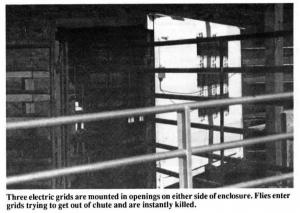1994 - Volume #18, Issue #3, Page #04
[ Sample Stories From This Issue | List of All Stories In This Issue | Print this story
| Read this issue]
First-Of-Its-Kind Electric Fly Trap
 |
The university, along with the USDA Agriculture Research Service, designed the trap which consists of an 8-ft. long, 3 ft. wide, 5 ft. high polyurethane enclosure that's painted white and is open on both ends. Three rows of plastic strips hang down inside to brush flies off the cow as she walks through the trap. Three electric grids are mounted in openings on either side of the enclosure. Flies enter the grids trying to get out of the trap and are instantly killed.
"You just set it up and forget about it," says Moreland. "Power for the grids comes from a 110-volt electrical outlet or a solar panel. The grids have small openings and work on high voltage but low wattage. Flies literally explode when they get zapped so they don't stick to the grids. Many flies that go out the open end of the chute eventually come back through the grids and are killed. They're attracted by the chute's bright white color or by the sound of flies circulating inside the trap.
"The inside of the trap is lined with wire panels so cows can't touch the grids. The trap can be used to kill flies even without cows going through it by placing it close to a barn. Lights inside the chute are on a timer and come on for about two hours during the evening and early morning to attract flies.
"We tested it extensively last summer and often saw dead flies 2 in. thick on the ground. We noticed that cows spent more time out on pasture during hot days and stayed much cleaner than in past years because they weren't being bothered by flies. It almost completely eradicated horn flies from a group of heifers maintained on pasture and greatly reduced stable flies when placed near the entrance of their housing barn. We found that it works best when placed between pastures or between a holding area and a feeding or watering area because it forces the cattle to pass through on a daily basis. The chute has a metal frame with hinges on it for gates that funnel cows into the trap."
Moreland says a manufacturer has shown interest in the trap and may have it on the market by this summer.
Contact: FARM SHOW Followup, University of Maryland College of Agriculture, 4240 Folly Quarter Road, Ellicott City, Md. 21042 (ph 301 596-9550).

Click here to download page story appeared in.

Click here to read entire issue
To read the rest of this story, download this issue below or click here to register with your account number.




